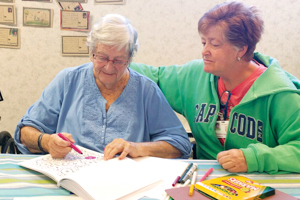Initiative focuses on five domains of suffering
By JULIE MINDA
A top goal of the long-term care facilities of the Carmelite Sisters for the Aged and Infirm is that every single resident will receive palliative care services from just after they arrive until they depart or die.
Ongoing comfort care has been a priority from the start of the congregation's work with the elderly beginning nearly 90 years ago, according to Sr. M. Peter Lillian DiMaria, O CARM, director of the Germantown, N.Y.-based congregation's educational institute. Over the last few years, the congregation has been intentional about formalizing its approach to providing holistic palliative care and standardizing that approach across their facilities. They serve in, sponsor or co-sponsor 20 facilities.

Sr. DiMaria
The effort has produced a program for determining how well long-term care facilities are delivering palliative care, training staff throughout the facilities to address five key areas of suffering and putting in place policies and practices to ensure that every resident is assessed for those domains of pain, and that each concern that surfaces is addressed.
The congregation's Avila Institute of Gerontology is making the program available to other long-term care facilities. Included is a white paper describing the institute's work on the project, an implementation guide, educational materials and an overview on tailoring end-of-life care to different faith traditions. The institute also plans to offer webinars on the program as well as consultation services. Some of the materials are free; there will be a cost for the consultation services.
"My hope is that (through this program) everyone gets a good understanding of palliative care," said Sr. DiMaria. "It is about compassion — we stay with persons throughout their pain and make them as comfortable as possible."
Hands-on guide
Sr. DiMaria said that while palliative care always has been provided by Carmelite long-term care sites, it was not known whether it was being delivered in a uniform way across the system. And so at the behest of the congregation's Central Ethics Committee, the Avila Institute began its baseline assessment and work on developing a systemwide approach. Sr. DiMaria and a team of palliative care and research experts worked with six Carmelite long-term care facilities to design, pilot and refine the program which was finalized this spring.
The implementation guide this group developed provides step-by-step instructions for long-term care facilities to set up a palliative care steering committee, establish palliative care teams in every unit, train staff and educate residents and family about palliative care. The guide covers how to ensure all patients benefit from palliative care.
Through this process, staff interview all residents or their family members to determine their needs related to physical, emotional, psychiatric, spiritual and familial pain. Staff develop palliative care plans to take up each issue that is found by the assessment. Staff monitor how well they are addressing the issues during weekly palliative care check-in meetings.
Staff also fill out narrative profiles that describe each resident's background and preferences, so that staff can better know the residents.

St. Patrick's Manor staff regularly assess resident Flora C. Antonucci's pain and then tailor support to her needs. Here, Antonucci enjoys a visit with daughter Elizabeth Antonucci.
Training for change
Sr. DiMaria, Avila Institute faculty and members of the Central Ethics Committee created the training curriculum on palliative care after talking with Carmelite sites about what was working and what wasn't working with their existing education programs. The experts also tailored materials from the End-of-Life Nursing Education Consortium, a national education initiative from the American Association of Colleges of Nursing to improve palliative care.
The resulting curriculum for Avila Institute's program includes PowerPoint presentations, teaching notes, case studies, handouts and reference materials that cover the principles of palliative care and the importance of managing different types of pain, advocating for residents, honoring residents' culture and faith traditions and taking an interdisciplinary team approach.
During the development of the program, Sr. DiMaria provided the curriculum to the steering committee at each pilot site, and the steering committees conducted train-the-trainer educational sessions. Those trainers teach other staff unit by unit. Since the pilot phase ended, Sr. DiMaria and Sr. Lois Wetzel, O CARM, a member of the institute's faculty, have been rolling out the program at Carmelite's 13 other long-term care sites.
Getting to know you
Geraldine Gracey is a nurse and clinical instructor and Joan Murphy is director of social services, both at the Carmelite sponsored St. Patrick's Manor, a 303-bed continuum-of-care facility in Framingham, Mass. They were members of the steering committee that rolled out the palliative care program at that pilot facility.
Murphy said that prior to implementing the formal program, their facility had provided palliative care to all residents, but the intensive focus on providing the services only happened when residents were declining or deteriorating. Now, staff create a palliative care plan for every resident. The findings on the domains of pain are captured in the resident's "24-hour log," which is a record of top priorities to be addressed for the resident. That places the pain needs top of mind for conversations among the resident's primary caregivers. Progress in addressing pain also is discussed in weekly palliative care team meetings and monthly meetings of nurse managers and social workers. The palliative care plan is formally updated quarterly.
Under the institute's palliative care program, Gracey said, caregivers came to view palliative care as a means to help residents lead more joyful, meaningful lives every day. The program also has helped staff understand the importance of continual education in palliative care, including on the five domains of pain, and of working together as a team, Gracey said.
Satisfaction
Murphy said that residents and families feel they are being heard.
The institute surveyed residents, family members and staff before and after the program implementation at the pilot locations. Results showed that each of the groups gained a greater understanding of palliative care. The residents and family members also reported greater satisfaction with the facilities.
Stacey Sumereau is the coordinator of program services for the Avila Institute. She expects staff satisfaction will increase as the approach becomes increasingly ingrained in each facility. "You give people a meaning (to their work) — a why — and they will find it more rewarding. If they love what they're doing, they will stay."
Sr. DiMaria and Sumereau said that the institute is making this palliative care program available just as special interest groups are pushing for physician-assisted suicide to be legalized in many states across the U.S.
Sumereau said that studies in Oregon, where physician-assisted suicide is legal, have found that most people who want to receive a prescription for drugs used in assisted suicide say they fear the loss of autonomy and independence; they worry about pain; and they worry about burdening their family. Properly delivered palliative care can address all of these areas of concern, she said.
Sr. DiMaria said, "If people could see how well palliative care can be done at every stage of a life-threatening illness, I would think they'd choose palliative care (rather than suicide). All of the concerns are answered with palliative care."
Information about the palliative care program is available from Sr. DiMaria at [email protected].
|
Five domains of pain
The five domains of pain used in the Avila Institute of Gerontology's palliative care program were first identified by Dr. Michael Brescia, executive medical director of Calvary Hospital in Bronx, N.Y. They are:
- Physical: Bodily pain left untreated can lead to loss of stamina and independence.
- Emotional: Feelings of sadness, guilt, regret and anger can be the most difficult to relieve, but should be addressed.
- Psychiatric: This suffering is caused by abnormal alterations in cognition, mood or behavior. Delirium and major depressive disorder are two psychiatric issues prevalent in nursing homes.
- Spiritual: Residents experience this pain when they feel a loss of connection with God. They often feel their lives lack meaning.
- Family: Sometimes family members do not fully understand or do not fully accept the disease process or situation of their loved one. Problems can arise when the expectations of family members or the residents themselves are at odds with reality.
|
Copyright © 2016 by the Catholic Health Association
of the United States
For reprint permission, contact Betty Crosby or call (314) 253-3477.